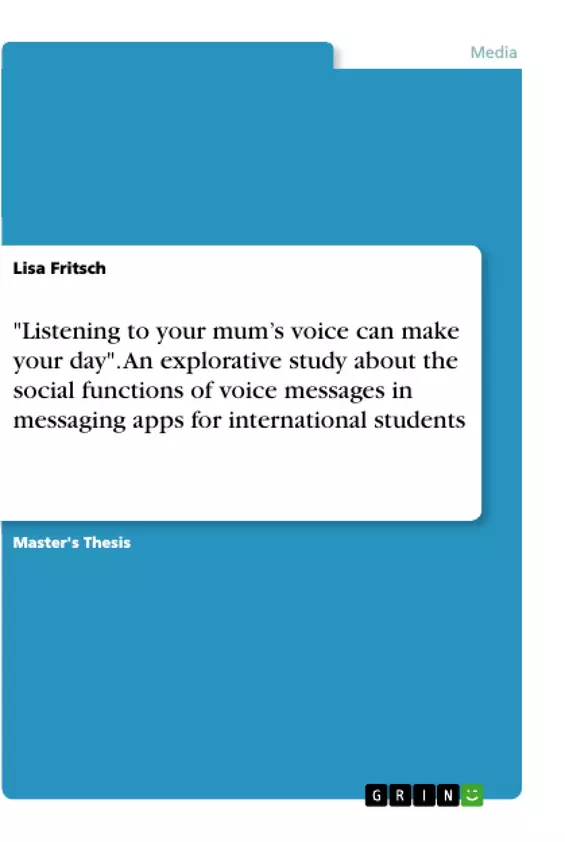Since 2013, voice messages can be sent using messaging services such as WhatsApp. Thus, the oral information transfer enters the digital messenger communication, which was previously exclusively based in written form. In German research of communication and linguistics, there are few scientists who have so far dealt with voice messages. They present a new challenge for the media linguistic conception of digital communication, as they fall into a gap between oral and written language utterances. The linguistics professor Katharina König emphasizes this decisive new aspect: "With the integration of voice messages[...] media orality enters the non-simultaneous, quasi-synchronous messenger communication." Voice messages bring a kind of ‘answering machine’ option to messenger chats. How does this change digital communication? What are the social functions for the interpersonal exchange of them?
These questions were investigated as part of a qualitative research, for which 20 international students between the ages of 20 and 34 were interviewed in Paris and Sofia. The selection of this sample favors the preservation of a homogeneous group of young adults in the same life situation. The research results showed that, despite the different countries of origin, the students have a similar usage of voice messages. The main benefit of voice messages is that they can be sent faster and easier and are therefore particularly practical in stressful situations. The speed allows more complex information to be recorded in less time. Furthermore, the increased emotionality through one's own voice and consequently a bigger intimacy between two chat partners, play an important role in the social functions of voice messages.
Inhaltsverzeichnis (Table of Contents)
- Introduction
- Aims of the study
- The procedure of the work
- State of research on voice messages
- Definition
- Functionality in different messenger apps
- International usage of voice messages
- Quantitative studies about the use of voice messages
- Theoretical classification of voice messages
- Between orality and literacy
- Monolog or dialog?
- Paraverbal characteristics
- Empirical study of voice messages
- Procedure and selection of the sampling
- Method
- Guideline and category formation
- Evaluation of results
- Category 1: Practicability and speed
- For the sender
- For the receiver
- For the length of the message
- Category 2: Complexity of the message
- Content
- Language
- Category 3: Emotionality and intimacy
- Emotionality
- Intimacy with the recipient
- Intimacy in relation to the place of reception
- Summary and discussion of results
- Conclusions
- Summary
Zielsetzung und Themenschwerpunkte (Objectives and Key Themes)
This Master's thesis aims to explore the social functions of voice messages in messaging apps for international students. The study investigates how voice messages impact digital communication and interpersonal exchange within a globalized context.
- The influence of voice messages on digital communication patterns
- The social functions of voice messages in interpersonal exchange
- The role of emotionality and intimacy in voice message communication
- The impact of voice messages on the relationship between orality and literacy in digital communication
- The differences and similarities in voice message usage across different cultural contexts
Zusammenfassung der Kapitel (Chapter Summaries)
The first chapter introduces the research topic, outlining the aims of the study and the research methodology. It highlights the increasing presence of spoken language in digital communication, particularly the rise of voice messages. The chapter also discusses the significance of understanding these new communication patterns in a globalized world, focusing on the communication behavior of young adults.
Chapter two reviews the existing research on voice messages, providing a definition, exploring their functionality in different messaging apps, examining their international usage, and analyzing quantitative studies on their use. This chapter sets the stage for the author's own empirical investigation.
Chapter three presents a theoretical classification of voice messages, analyzing them in terms of their relation to orality and literacy, their role as monologs or dialogs, and their paraverbal characteristics. This chapter provides a theoretical framework for understanding the social functions of voice messages.
Chapter four describes the empirical study, outlining the procedure and selection of the sample, explaining the research method used, and detailing the formation of the categories used in the analysis.
Chapter five presents the evaluation of the results, focusing on three main categories: practicability and speed, complexity of the message, and emotionality and intimacy. This chapter explores the factors influencing the use of voice messages and their impact on interpersonal communication.
- Quote paper
- Lisa Fritsch (Author), 2019, "Listening to your mum’s voice can make your day". An explorative study about the social functions of voice messages in messaging apps for international students, Munich, GRIN Verlag, https://www.grin.com/document/511680



